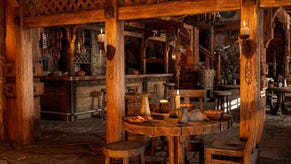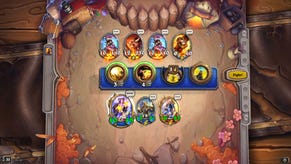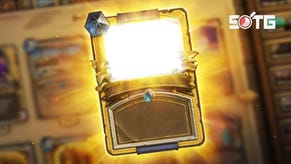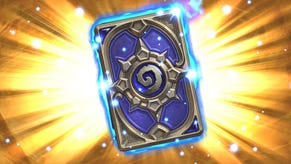Discovering Hearthstone's League of Explorers
Fortune and glory.
Hearthstone always finds it greatest moments when it drinks deeply from its thematic inspiration. For The League of Explorers, that means a dusty trawl through the ancient echoing catacombs of WoW's more adventurous desert dungeons. Not only are the encounters tremendous fun, but this third Adventure for Hearthstone - going by this first of four drip-fed wings at least - is shaping up to be the high point of the game's tentative journeys into single-player content.
First up in the Temple of Orsis wing is a showdown with the genie Zinaar. He's great to fight, and adds a new type of spell card to the game in the form of Wishes. Before the djinn can contemplate the move from the cards in his hand, he is first compelled to grant you a randomly selected Wish. Playing this card on your next turn might reward you with a minion of a certain resource cost, for example, a random spell, or even two new Wishes altogether.
What these cards really amount to is a taste of the new Discover mechanic that's being introduced with this Adventure. When a card with this new keyword is put into play, you gain the chance to select one of three appropriately flavoured cards, and those cards need not even exist in your collection. You might get to pick a four Mana-cost minion (one of the most important resource brackets in the game), or receive a spell that could help you fight back from the brink of disaster.
When the Adventure was announced at Blizzcon, I admit I was a little fearful about yet another new mechanic being added to Hearthstone, and so soon after the rather feebly fleshed-out Joust and Inspire mechanics that came with August's Grand Tournament expansion. Discover feels like a genuinely exciting addition though, and provides a real dash of spice to a game that was losing a little of its fizzle, even as dozens of new cards were being poured into the mix.
What makes Discover work, I think, is that it isn't an entirely random process that would produce nonsensical results more often than not, and yet it also doesn't feel like too artificial a fudge either. The weighting process taking place behind the scenes is a gentle thing that respects the need for a player to earn their glory. That the new mechanic also helps new players with thinner card collections compete on the playing field feels like a step forward for Hearthstone too, and an entertaining solution to a problem that the team acknowledges needs further work.
Once you've made your Wishes, traded minions and stuffed the genie back into his bottle, you move onto a fight with Sun Raider Phaerix. In this battle, the boss is invulnerable as long as a special rod remains in his possession - pinch it off him, however, and you'll be able to start whittling down his health, while enjoying the rod's protection for yourself. There are some very cheap ways to deal with this mechanic, but if you play it straight you receive an appropriately fair fight in exchange.
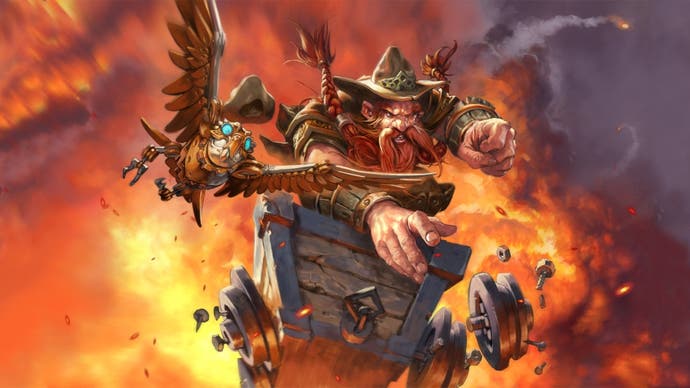
The Temple of Orsis saves its truly innovative treats for the final third of the experience, however, and it's here that you fight through a series of obstacles and attempt to survive the ten turns that lie between you and daylight. Unfortunately, it proved to be a feature that was refreshing and frustrating in equal measure.
Part of this section's heavy scripting, for example, sees the ceiling crumble and wipe out everything on the board. You receive advance warning a turn ahead of time, but no indication of what will actually happen, and so you play inefficiently. Perhaps you waste that big removal spell you'd been holding onto, and that would otherwise have helped you reach daylight on your first attempt. The result is to rob you of the satisfaction of thinking on your feet, and it brings the thrill of the whole thing crashing back to earth, just as the end is in sight.
On normal mode, and in keeping with previous Adventures, you can clear the majority of these challenges with just about any type of established deck archetype in Hearthstone, from the meatily resilient Control Warrior to the most aggressive and rapid-fire flavour of Face Hunter. For the seasoned player there's not much of a challenge, but it's at least entertaining for veterans to approach each fight from vastly different positions. At the same time, new players - with lesser card collections - have their own fair chance at all of these treasures, including the new class-specific cards rewarded for solving fun puzzles using pre-prepared decks.

It's the new Reno Jackson card that's picking up all the attention in the immediate aftermath of the first wing though. It's impossible to say right now whether his huge healing potential - triggered only if your deck pile contains unique cards - will prove to be be consistently powerful enough to justify such a radical departure from the more traditional approach to deck-building. Far better Hearthstone players than I declared that the now-ubiquitous Dr. Boom would never see competitive play, so it is perhaps better to wait on the sidelines in this instance, and see what impact this card and others will have on the broader metagame once the adventure is over.
Hearthstone needed a bit of fun thrown back in and it needed it far more than The Grand Tournament's massive influx of cards, which proved to shake up the metagame far less than the community needed. Time will tell whether The League of Explorers can deliver on this first wing's promise of providing fun in tandem with healthy disruption, but Hearthstone's future finally feels rather exciting once again.
To stay on top of all the latest Hearthstone developments, take a look through our dedicated Hearthstone site MetaBomb.





